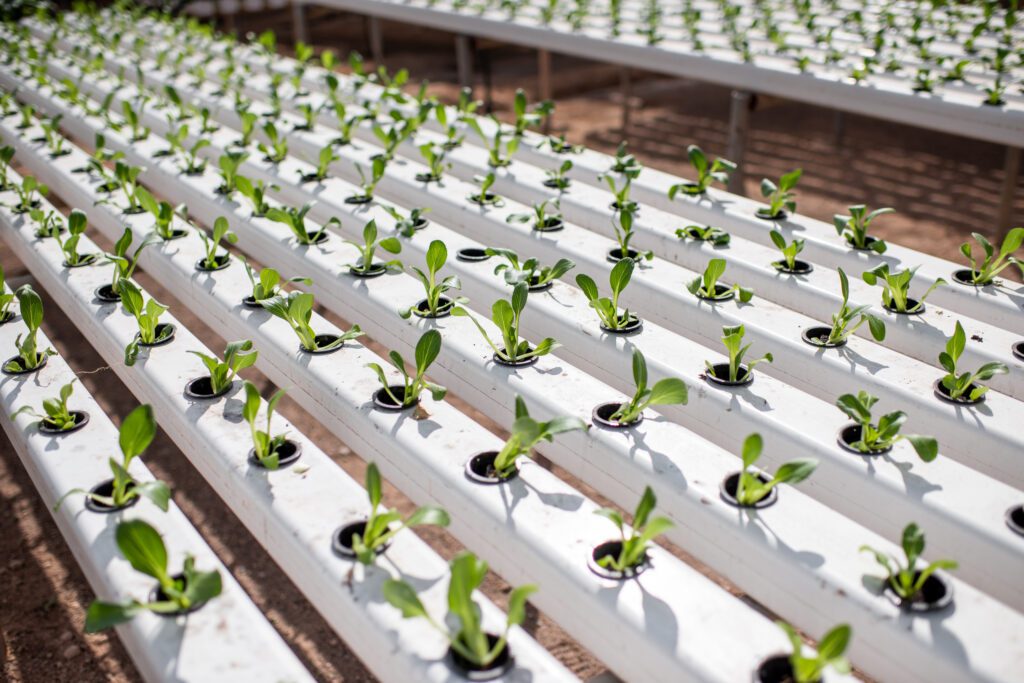Hydroponic farming is one of the most popular modern farming techniques which forms part of the hydroculture family of farming. It doesn’t utilize soil, rather uses nutrient-rich water as the carrier of nutrients that help plants grow and thrive. Nutrients like calcium, phosphorus, nitrogen, potassium, etc. are added to the water and the water is circulated throughout the farm with the help of a hydroponic system. A healthy yield is guaranteed given faster and more monitored absorption of nutrients is promoted with the help of nutrient solutions that can be tailored to suit the crop.
Another special feature of hydroponic farming is that it can be conducted in racks. It is a popular technique often used in city farms as vertical farm space is often well utilized, thereby maximizing yield per square meter and maximizing space utilization. Hydroponic farming also extracts maximum usage out of the water (and space) and minimizes input (reusable nature of the nutrient-rich water), making hydroponic farming one of the most sustainable and efficient forms of agricultural practices and one where the cost keeps on diminishing with time – long-term benefits outweigh one-time costs.
In order to establish your own hydroponic farming set-up, there are a few steps that can act as a holistic reference guide; coupled with more detailed knowledge on how to start hydroponic farming (online course available at www.rocketskills.in), you can use the following steps for your reference along the hydroponic farming journey.
Procure a Reservoir
A reservoir is essentially the container wherein you’ll be storing your nutrient-rich culture water. This container is usually made of plastic or any other non-oxidizing material and one can also use old fish tanks as used in BFT fishing to make this container. This is where the water is stored before it is circulated in the hydroponic system and a similar container is often used to collect the water back.
The collected water is reinforced with nutrients and the same water thereby keeps traveling in the hydroponic system for a long time. One no-go area for these reservoirs is reactive materials such as metal – avoid using containers made of such material in order to prevent contamination of your water which could meddle with the nutrient mix and react negatively with the plants.
Build a system of Grow Trays or Grow Chambers
In order to maximize utilization of a tank of nutrient-rich water, it is imperative to maximize the surface area that this water can touch and thereby provide the nutrient-rich culture to more plants than if such plants were grown directly in the reservoir. To achieve this objective, grow-trays and grow-chambers are connected to each other such that this water can flow into a pipe-like system at the bottom of these trays and feed a monumentally larger number of these saplings than otherwise. The use of trays also ensures that the water keeps moving and aerating, and thereby remains nutrient-rich till the very end of the system.
Fortify with Growing Medium (your plants’ spinal cord in essence)
Even though the hydroponic system does not use soil, the plants growing therein need some sort of a support system within which they can grow. In other words, the plants need a growing medium which, even though doesn’t cater to the nutrient requirement of the plants, but fulfills the structural necessity. To support the plant’s weight and roots, growing systems are often made of gravel, sand, foam, coconut threads, and other such sturdy material. Expanded clay and Rockwool are often used commercially as they last for a long time, and have neutral pH thereby not hampering the nutrient content of the culture water. Their airy nature also provides breathability to the samplings.
Develop the suitable blend of Nutrient Solution
This is the most essential step in driving the success of your hydroponic farming setup. Each crop or variety demands a different blend of nutrients in different concentrations. Therefore, it is important to know your plants well and take an expert’s guidance as to the appropriate nutrient blend for your crop of choice. Further, some crops fare better in the dark while some demand light, whether natural or synthesized. Coupling the ideal nutrient solution with the ideal environmental factors is pivotal to plant health and the overall success of your hydroponic farm.
Install a Delivery System
Remember we walked about the water moving across from one sapling to another? This is the function of the delivery system. Essentially, grow trays are trays with holes for plants or saplings to be able to stay suspended in the support medium like gravel. These trays are laterally connected with each other and the delivery system, much like a pipe, flows through the growing medium such that the roots of the saplings find themselves suspended into the pipe. These pipes have holes on the top and these holes align with the holes in the growing trays.
Complete with an Air Pump
Much like an air pump in an aquarium, the predominant function of an air pump is to keep the culture water well aerated and oxygenated. Further, an additional feature of an air pump with regard to a hydroponic system is that it helps move water from the nutrient-rich reservoir into the delivery system comprised of pipes, trays, and a growing medium. It is important to keep the water moving both within the reservoir as well as in the delivery system to discourage stagnation, which brings with it unwelcome side effects, such as the growth of algae which may mooch off nutrients that are meant for the saplings.
While these are the basic steps that you must undertake in order to create a hydroponic setup, the components within these steps range from absolutely basic (usually in home-setups) to extremely sophisticated (as in most large commercial setups). Your end objective with hydroponic farming as well as your budget would govern the kind of components, equipment, and scale you go for.


